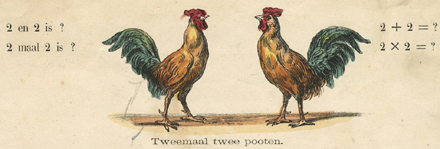Nineteenth century school books > About the collection

The 200 books in this Collection, all of them belonging to the collection of the Nationaal Onderwijsmuseum (National Museum of Education) in Rotterdam, give an insight into how national education developed in the Netherlands during the years 1780 – 1900. In that period education became more important because of the enlightened idea that society – and, therefore, children – are makeable. For six centuries, Catholic priests and, after them, Protestant ministers had used education to propagate their own religious ideas. Then things began to change. Discerning minds started to have doubts about the way education was regulated. Inspired by the Enlightenment, they argued that the mind – the reason – was mankind’s most valuable asset, that it is the mind which distinguishes man from all other creatures. A good education can activate the mind and transform ignorant and superstitious people into cultivated and sensibly thinking citizens.
The little volume of poetry Kleine gedigten voor kinderen (Little poems for children), written by Hieronymus van Alphen between 1778 and1782, is full of very modern views for the time, though it is difficult to imagine when reading the book nowadays. It is an example of a book containing enlightened ideas. Van Alphen sees the child as an empty page, a being who can be taught virtues like obedience, respect for his parents and God, as well as modesty. This basic assumption also features in Nicolaas Anslijns’s famous booklet De brave Hendrik (1810). But views on education did not stand still and in 1861 the governors of the Amsterdam Stadstusschenscholen (Municipal primary schools) made suggestions for new textbooks to be used for the various subjects. In their proposals, they wrote, among other things:
“Onder de leerboekjes voor de laagste klasse wordt door Curatoren voorgesteld de geheele reeks, waarvan de Brave Hendrik het begin en de type is. Liever zagen wij deze door andere vervangen. Wij willen wegens dit oordeel allerminst geacht worden op zedelijkheid en godsdienstzin geen prijs te stellen, of aan voorbeelden van slechte kinderen de voorkeur geven boven die van brave maar wij vinden de braafheid van Hendrik te onnatuurlijk en wij missen in deze boekjes den spoorslag tot krachtsontwikkeling en energie, waaraan juist zoo groote behoefte bij ons volk bestaat”. [Among the textbooks for the lowest class, the Governors mean the whole series, of which De brave Hendrik is the beginning and the type. We would prefer to see these replaced by others. We do not in the least want to be seen as failing to value virtuousness and religiousness, nor as preferring naughty children to well-behaved ones because of our opinion, but we consider Hendrik’s good behaviour too unnatural and we miss in these books the incitement to develop strength of character and energy, of which our nation is precisely in such dire need].
In reaction to the oh-so-virtuous books mentioned above, new titles appeared, including De geschiedenis van Jozef (The story of Joseph), Moeder Anna en hare kindertjes (Mother Anna and her children) and De historie van twee appeljongens (The story of two little apple sellers). These also have a moralizing tone, but all the texts are nonetheless written a bit more lightly and smoothly. The child plays an increasingly central role as a being in the process of discovering himself. In the history and geography books we encounter the increasing influence of government on society, a characteristic of that period, and the population’s growing consciousness of nationhood. The heroification of great men such as the great admiral Michiel de Ruiter and Prince William of Orange, called William the Silent, was widespread. Many pages are devoted to tales about the Teutons and the events of the Eighty Years’ War. A good example of this new trend is De kleine vaderlander, iets uit de geschiedenis van Nederland voor de middelste klasse der lagere school (The little patriot; something from the history of the Netherlands for the middle form of the primary school) by J. Wijma.

By the end of the nineteenth century, teaching had increasingly become the domain of educationalists and other specialists. At the time, one of the subjects of debate was the role that images should play in teaching. The proponents of teaching with visual aids claimed that children are better able to absorb the lessons if they can associate the subject with pictures or illustrations. Please view the Leerzaam prentenboek (Instructive picture book) by W. Degenhardt for an example. In his preface, the author wrote:
“Zelf iets doen is bij de kleinen een groote pret; daarom zijn Thermometer, Barometer, Pendule en Kompasroos zóó ingericht, dat ze door de kinderen behandeld en daarmeê allerlei vragen beantwoord kunnen worden. Ik meen dat op deze wijze het genoegen van het samen zien en praten niet weinig vermeerderd zal worden”. [Doing something themselves is great fun for small children. Therefore, thermometer, barometer, clock and compass rose have been set up in such a way that children can handle them, thereby providing an answer to all kinds of questions. I feel that the pleasure of being together and talking together will be much greater this way.]
In the Netherlands, the strongest advocates of this approach were Eli Heimans, Jac. P. Thijsse and Jan Ligthart. They preferred to leave the confines of the school and show children the real thing. Jan Ligthart, for one, wrote the popular series of readers Nog bij moeder (Still at home with mother ), in which Ot and Sien are the main characters. In this series, Ligthart wanted to demonstrate how important it is for young children to have committed and attentive parents.
